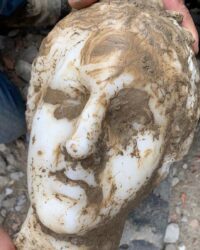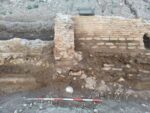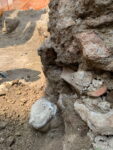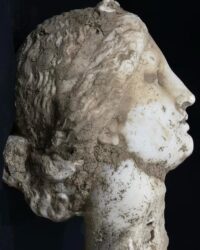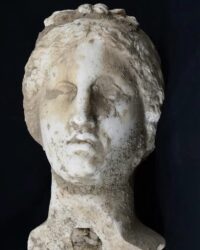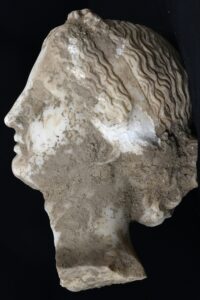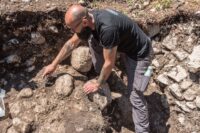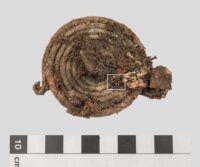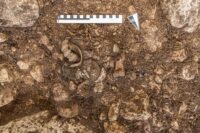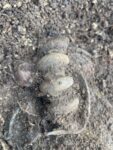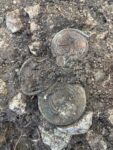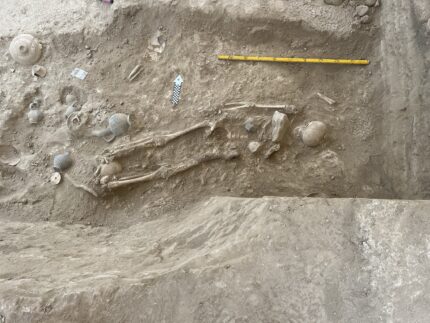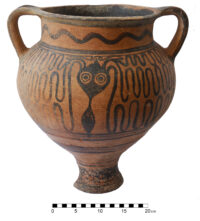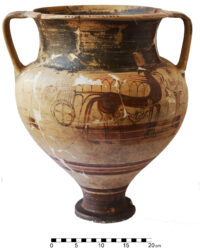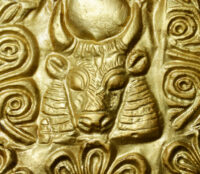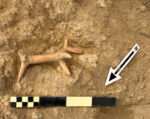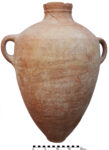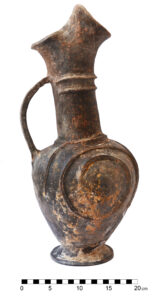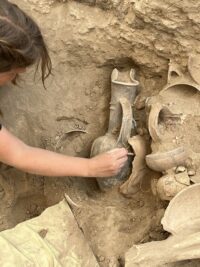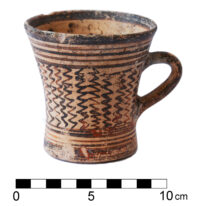An unusual burial of a Roman soldier, his iron sword, crossbow fibula and hobnailed shoes attesting to his profession and rank, has been discovered in Wales. He was buried face-down in prone position and large nails were found at the back of his neck, shoulder and between his feet. This atypical posture and the presence of the nails indicate he may have been bound in strong restraints before burial.
He was not enslaved or your garden variety criminal, as such a burial position might suggest. He was not tossed into a pit, but carefully placed in a rock-cut grave edged with wooden planks. The sword found between his legs is the long and straight spatha type that replaced the short gladius as the standard infantry weapon in the 3rd century A.D. The silver crossbow brooch marks him as a person of high position in military or civil administration, and it is the first of its kind ever discovered in Wales.

 Crossbow fibulae came into use in Late Antiquity, from the late 3rd century through the middle of the 6th century A.D., in the Western and Byzantine Empire. They were worn as cloak fasteners by military officials and civil servants and came to be strongly associated with military and civil authority. Richly ornamented examples made of precious metals were given as gifts for service to senior imperial officials by Roman emperors. Great general and power not-so-behind the throne Flavius Stilicho (365-408 A.D.) was depicted wearing one, and common Roman soldiers took up the trend, sporting cheaper versions in bronze and copper.
Crossbow fibulae came into use in Late Antiquity, from the late 3rd century through the middle of the 6th century A.D., in the Western and Byzantine Empire. They were worn as cloak fasteners by military officials and civil servants and came to be strongly associated with military and civil authority. Richly ornamented examples made of precious metals were given as gifts for service to senior imperial officials by Roman emperors. Great general and power not-so-behind the throne Flavius Stilicho (365-408 A.D.) was depicted wearing one, and common Roman soldiers took up the trend, sporting cheaper versions in bronze and copper.
Analysis of the soldier’s burial dates it to the 3rd or 4th century. He was between 21 and 25 old when he died, and was suffering from a bacterial infection of the mastoid bone at the time of his death. Stable isotope analysis found that he was not a native of the area. He was born and raised east of Wales.
 The grave was unearthed in Vale of Glamorgan in 2017 by Rubicon Heritage Services archaeologists in advance of a road building project. It was in a field used for agriculture in the Roman era, not in a dedicated cemetery, although another four burials were found at the site. One of them contained the remains of an individual who had been decapitated and his head placed at his feet. Decapitated burials and prone burials often occur together.
The grave was unearthed in Vale of Glamorgan in 2017 by Rubicon Heritage Services archaeologists in advance of a road building project. It was in a field used for agriculture in the Roman era, not in a dedicated cemetery, although another four burials were found at the site. One of them contained the remains of an individual who had been decapitated and his head placed at his feet. Decapitated burials and prone burials often occur together.
Researchers have begun to pay more attention to patterns of atypical burials in Western Europe during the Roman period, but so far, no single explanation for these kinds of burials has been found. Whether
it was for low-status individuals, criminals or those their communities wanted to ensure “stayed dead,” cross-culturally, prone burials are never seen as a positive way of disposing of the deceased.
This Roman soldier is therefore something of a mystery — one that may never be solved. “It is interesting that he was buried prone but still with his ‘regalia,'” Collard said. “Raises more questions than answers!”

